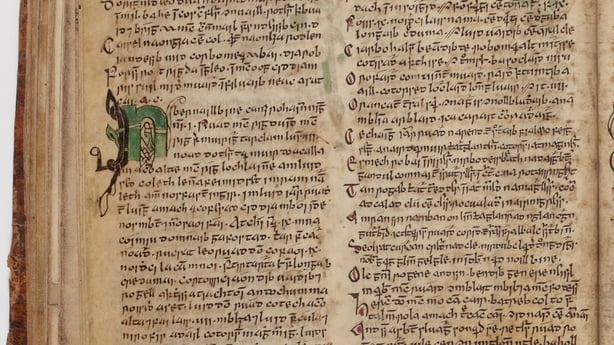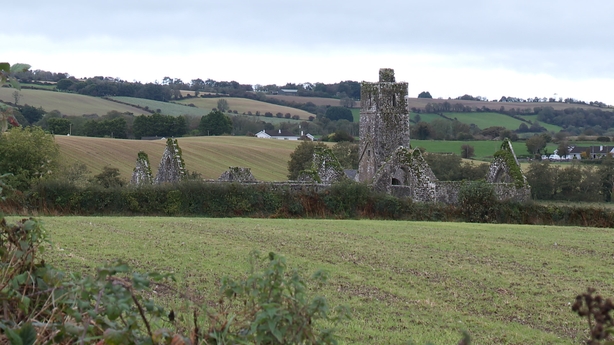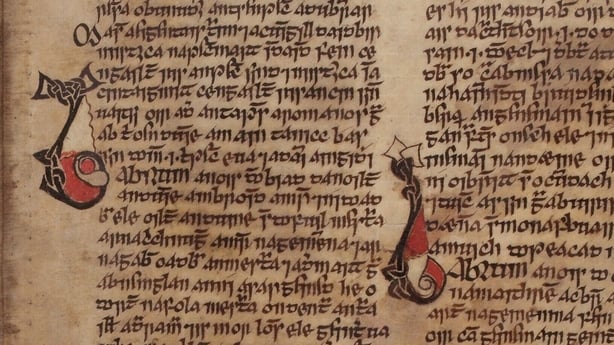A rare 15th century Irish manuscript found in France has been returned to Ireland for public display.
Known by scholars as the Rennes Manuscript, it is believed the precious book may have been brought to France by an Irish army officer or noble person during the exodus of the 'Wild Geese’ in the late 17th century or early 18th century.
The 200-page vellum manuscript is on public display in the Glucksman Gallery in University College Cork, having been secured on loan from the city library in Rennes, Brittany.
The Rennes manuscript is beautifully decorated and contains a variety of material, including religious texts, place lore known as ‘dinnsheanchas’ and a copy of the earliest known Irish translation of ‘The Travels of John Mandeville’, made in 1475 by Fínghean Ó Mathghamhna.
The manuscript is believed to have been compiled during the second half of the 15th century, possibly during the 1470s.
Notes contained in the text indicate that the manuscript remained in Ireland until at least the 1640s.

The assumption is that the manuscript, like many more, was then taken to France during the exodus of the ‘Wild Geese’ in the 17th and 18th century.
Following the signing of the Treaty of Limerick in 1691 many Irish soldiers that served in the Jacobite Army are known to have been exiled in Brittany.
The manuscript was eventually purchased by Christophe-Paul de Robien (1698-1756), President of the Parliament of Brittany, who added it to his vast private collection.
However, during the French Revolution the contents of the de Robien library were confiscated and the manuscript became part of the public library in Rennes, where it has been held ever since.
Professor Pádraig Ó Macháin said the manuscript is in remarkably good condition and illustrates the depth and quality of texts which were compiled by Irish scribes in the 1400s.
"We know that many, many books were taken abroad during that period, but very few survived. Irish manuscripts were also written on the continent from sources that were available there, so we know there must have been a big circulation of manuscripts and here’s one that survived," Prof Ó Macháin said.

"It’s very important for our undergraduate students that they get to see these marvellous books that we talk about in our lectures and here we have a remarkable opportunity to do that - to see such a beautiful manuscript in the flesh is a special experience," he added.
Research carried out by Dr Andrea Palandri indicates that Tadhg Ó Ríoghbhardáin, a travelling scribe, is the author of the book.
The Ó Ríoghardáin family were historians to the Ó Cearúil clan on the Tipperary/Offaly border area.
"He was a professional scribe who travelled around Ireland, collecting important texts which he then copied in manuscripts, with certain patrons in mind, important families and chieftains." said Dr. Palandri.
Part of the Rennes Manuscript was written in Cill Chré (Kilcrea) about 20km outside Cork city, where a Franciscan Friary existed, as well as a castle which was the stronghold of Cormac Láidir Mac Cárthaigh of Muskerry.

"The scribe leaves us a note in the text telling us that he is in Cill Cré on Maundy Thursday during Easter Holy Week and he comments about the piety of the community there which has only given him the eucharistic host to eat, leaving him hungry." Dr. Palandri said.
The Rennes Manuscript has been put on display alongside the Book of Lismore another important Irish manuscript from the same period.
The Book of Lismore was written for Fínghean Mac Carthaigh Riabhach, Lord of Cairbre 1478-1505. In 2020 the Duke of Devonshire and the Chatsworth Settlement Trust donated the book of Lismore to UCC.
The exhibition entitled ‘Return of the Exiles’ has been supported by Foras na Gaeilge and will continue at the Glucksman in UCC until the 4 November.







